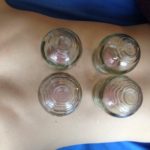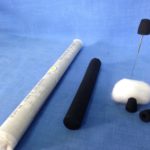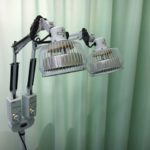Cupping and moxibustion, Geelong
Cupping Therapy
What is cupping?
Cupping is a long-practised treatment used in traditional Chinese medicine (TCM). Cupping involves placing vacuum cups on the skin to create suction. This pressure is used to stretch skin, tissue and tight muscles upward. The suction assists healing by relieving muscle tension, increasing blood circulation, and with it the flow of “qi” in the body (Qi is a Chinese word meaning life force).
Cupping is often practised alongside acupuncture but can also be used as a treatment in its own right.
Cupping is not painful, however it can leave temporary reddish-purple patches on the skin that look like bruises, especially if there is an injury or energetic blockage under the area that was cupped. The discoloration on the skin shows there has been movement or change in the circulation of blood in the treated areas. Although these marks resemble bruises, the muscles are not injured. The skin discoloration can last from a few days to a couple of weeks, but is rarely painful.
Types of cupping
Traditionally, cups were made from animal horn or bamboo, and later on from ceramics. Modern cups for vacuum cupping include glass, plastic, rubber and silicon; all with various ways for removing the air inside the cups and creating a vacuum, such as fire, hand pump, balloon or compression. There are two main methods of dry cupping (which is a suction-only method) used at Geelong Chinese Medicine Clinic:
- Fixed / static cupping – where cups are placed on a selected area and left.
- Siding / moving cupping – where massage oil or cream is applied on your skin, then the vacuum cups are slid over the areas to be treated.
What conditions is cupping used for?
Cupping has long been used to treat a wide variety of conditions. While cupping can be especially effective at easing muscle aches and pains, the cups can also be applied to major acupressure points, influencing the treatment of conditions commonly treated with acupuncture. A 2012 review of cupping therapy found that cupping therapy may help with a variety of conditions, but acknowledged more high-quality studies were needed to assess the true effectiveness of cupping.
A review of cupping therapy clinical trials showed cupping may help in certain conditions under the following areas:
- Musculoskeletal issues
- Respiratory issues
- Digestive issues
- Pain syndromes
- Gynaecological disorders
- Dermatological conditions
While considered relatively safe if applied by appropriately qualified practitioners, cupping is a specialist technique and is contraindicated in certain cases. It is therefore very important to visit AHPRA-registered practitioners. All practitioners at Geelong Chinese Medicine Clinic are registered with AHPRA and are highly experienced in applying cupping. Based on your condition and preference, we will choose the best cupping method for you.
Moxibustion
Moxibustion is a form of heat therapy, as Chinese medicine understands some presentations are cold in nature, whereas others are hot. Moxibustion uses a heat generating herb to produce warmth. There are a number of forms of this therapy.
TDP Infrared Heating
This is the modern form of moxibustion to produce warmth. This therapy is effective for any presentations that Chinese medicine considers with a cold nature. This is different from commonly used heat packs.



